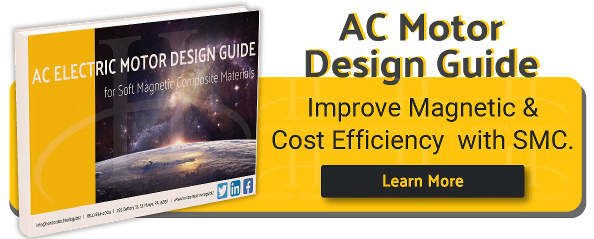No one process is consistently perfect for every single manufacturing application. There are times when electrical steel lamination is clearly the better option for a particular production need, and times when another process might be more effective.
For example, one area where powder metallurgy has come a long way is in creating small parts for industries such as electric motors. The ability to produce net shape products such as gearbox and motor parts for the auto industry, and the availability of advanced materials and process, open up new opportunities every day.
Powder metallurgy is breaking into more and more electrical applications, but how does it stack up (literally) against those old-school electrical steel laminations? Turns out some electrical steel uses and applications should stay as such, while sometimes powder metal is a great alternative.
Let’s look at why engineers are still working with electrical steel and whether they’re missing out on opportunities in some cases:
Electric Steel Uses: A Quick Brush-Up
Electrical steel goes by a lot of different names:
- Lamination steel
- Silicon electrical steel
- Silicon steel
- Relay steel
- Transformer steel
No matter the name, it’s an iron alloy tailored to produce specific magnetic properties. A lamination stacking method is used to form the laminated cores of transformers, as well as the stator and rotor of electric motors. This is because it’s challenging to produce single rounded parts with electrical laminations.
Electrical steel is created via stamping. In general, if you can stamp a part, then powder metal is probably not a good fit due to the three reasons below:
Advantages of Electrical Steel
1. Cost, Usually
Certain silicon steel laminations only cost 50-60 cents a pound, and the stamping process is relatively cheap. Taking both materials and production into consideration, electrical steel can represent a cost savings relative to powder metallurgy.
You’ll certainly need to consider whether powder metal’s performance benefits outweigh the cost increase.
2. Performance
Many silicon steel mechanical properties are useful for a variety of performance reasons, including:
- Low power loss per cycle (at frequencies less than 500 Hz)
- Low core loss
- High permeability
In some cases, such as conventional motors, motor lamination steel is clearly the better choice over a soft magnetic powder. The main reasons? Torque and energy consumption.
3. Familiarity
Electrical steel applications have been set in stone for decades, and most engineers are comfortable with their abilities. It’s a safe and accepted approach to building electric-based parts.
Soft magnetic composite (SMC) powders and other powders for electromagnetic applications are newer and less familiar. It can be very difficult to change minds and move on to different shapes and approaches.
Uses for Lamination Steel
The three main uses of lamination steel today are:
- Motors (stators, etc.)
- Generator materials
- Transformer components
Motors are everywhere you look and then some: from the modern refrigerator and dishwasher, to the little turning plate in the microwave. Notably, powder metal is not part of the transformer conversation yet. But in other cases -- namely, motors -- it certainly should be.
Disadvantages of Stamping
The disadvantages of electrical steel are in the shortcomings of the process used to make it more so than with the material itself. Disadvantages of metal stamping include:
- Design limitations: You are pretty much working in 2D, as there are no 3D design capabilities like you’ll find in powder metal.
- Thickness limitations: Stamping is commonly limited to sheets of 0.5” or less. Your manufacturer may also have a minimum thickness requirement. This thickness applies only to stamping for structural applications; relative to electrical steel laminations, the thicknesses vary from 0.05” to 0.007”. The SMC process can also incorporate smaller particles that perform better at much higher frequencies.
- Forming limitations: Secondary features need to be added later in production. Powder metal features can be done in a single mold.
Where Does Powder Metal Fit With Motors?
The performance capabilities of powder metals have developed far beyond the simple mixes of decades ago. Today they represent a whole lot of untapped potential for motors and other applications.
- Greater magnetic properties
- Higher strength
- Improved hardness
Let’s not forget about the “from scratch” batter-like formability of powder. The unique shape-making of powder metallurgy is perfect for when you need to design with complex, 3D geometry.
Click here for more on the shape-making advantages powder metal offers over laminations.
You may have noticed the “usually” disclaimer when we said laminations were the most cost-effective option. Why? The ability to form those rounded, 3D shapes with powder metal allows you to reduce the number of assembly pieces in a product. If the consolidation of parts is great enough, going with powder metal may actually be more affordable than laminating.
Have Your Cake and Eat It, Too
Laminations have been around since the advent of motors, and they were great. But are they necessarily the best solution for your current application? Lamination might produce a nice, flat part, but what if your part is not flat, or requires other details? What if you need a batter-like material to play around with?
One interesting advance is the ability to produce a combination component that is part lamination, part PM. With stamping, you’re just taking plates and stacking them, which can be very limiting in terms of shape. But with powder metal, for example, you can make an end cap so wire bends right around the material nicely. This creates more efficiency for the motor and gives the motor manufacturer the benefit of both worlds — the low cost of stamping and the minimized additional cost of SMC material, while still increasing motor efficiency.
Is Good Good Enough?
It may be time to rethink your engineering practices. Other companies (*cough, Porsche, cough*) are doing it. A good start is to check out the educational and visual look at SMCs below:



